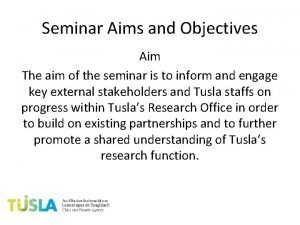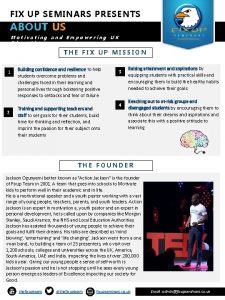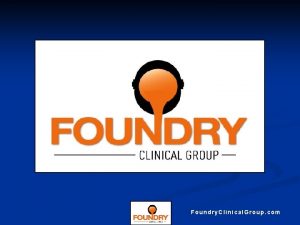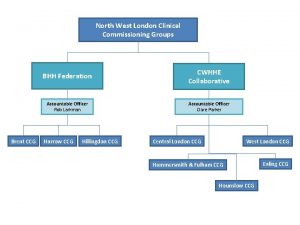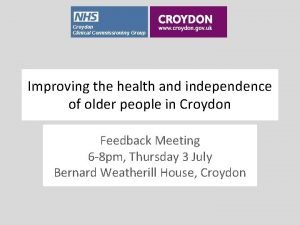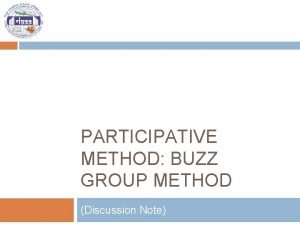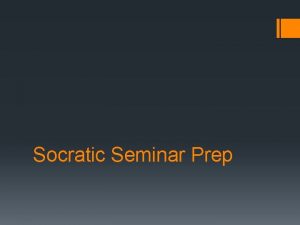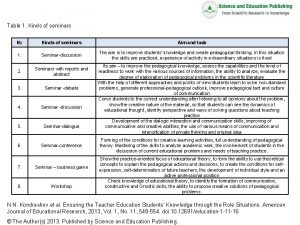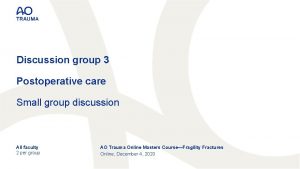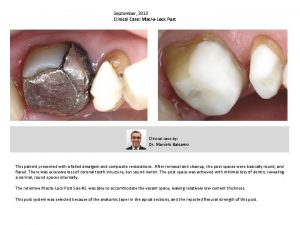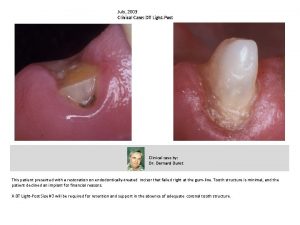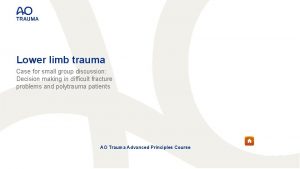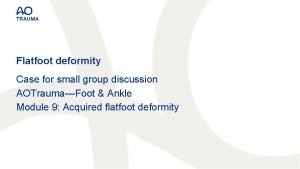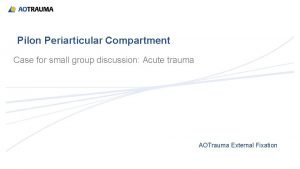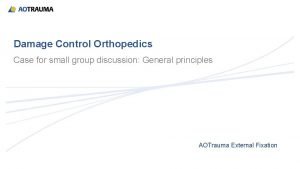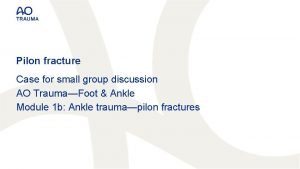Small Group Discussion Small group seminars Clinical case






















- Slides: 22

Small Group Discussion

Small group seminars Clinical case 1 - Thyrotoxicosis

Case history • Mrs. A. B. was 25 years old when she became pregnant for the first time. The pregnancy was uneventful and no thyroid function disturbances were recognized. • At about ten weeks postpartum, she became increasingly fatigued and irritable with episodes of palpitations. She was seen by an internist because of these symptoms.

Physical Examination • She appeared anxious and hyperkinetic. Her pulse was 120/min, BP 130/60. Her skin was warm, moist and smooth. She had lid lag and normal ocular motility. The thyroid was diffusely enlarged, with a prominent isthmus, and was estimated to weigh approximately 40 grams (2 times normal size). She had a bounding cardiac apical impulse, a pulmonic flow murmur, and a systolic bruit over the thyroid. She had a fine tremor and rose from a deep knee bend with difficulty. The rest of the examination was unremarkable.

Laboratory data • Serum. T 4: 16μg/100 ml (normal 4. 5 -10), • Serum T 3: 550 ng/100 ml (normal 75 - 180).

Objectives of the seminar 1. What is your differential diagnosis? 2. Are more tests required to define thyroid status? 3. What additional physical signs would strengthen your preferred diagnosis? 4. Describe the expected clinical course for 2 of the possible diagnoses and what therapy would you recommend? 5. What is the cause of the a) pulmonic flow murmur? b) the thyroid bruit? c) lid lag? 6. Is there any contraindication to future pregnancy?

• Postpartum thyroiditis is defined as the occurrence of thyrotoxicosis followed by hypothyroidism or hypothyroidism alone in the first year following pregnancy in women who did not have overt thyroid disease before pregnancy • This autoimmune thyroid disorder is precipitated by the postpartum immunological rebound that follows the partial immunosuppression of pregnancy, in individuals already at risk of autoimmune thyroid disease.

• The overall prevalence of postpartum thyroiditis is approximately 8% of pregnancies. • Several high-risk groups have been identified including those with type 1 diabetes (19. 1% prevalence), a positive family history (20. 0%) and/or a previous history of postpartum thyroiditis (42. 4% recurrence risk) • Postpartum thyroiditis is a destructive thyroiditis associated with lymphocytic infiltration and histological features similar to that seen in Hashimoto's thyroiditis, without the same degree of fibrosis and follicular atrophy.

• There is strong evidence that women who develop postpartum thyroiditis have evidence of thyroid autoimmunity prior to pregnancy demonstrated by the association with the presence of anti-thyroid peroxidase antibodies (TPO-Ab) • TPO antibodies are seen in all forms of autoimmune thyroid disease including Hashimoto's thyroiditis, Grave's disease and postpartum thyroiditis. The level of the antibody titer reflects the severity of lymphocytic infiltration within the gland

• The primary differential diagnosis during the hyperthyroid phase is Grave's disease • Differentiation may be possible on clinical grounds or by the absence of thyroidstimulating immunoglobulins in the hyperthyroid phase

Small group seminars Clinical case 2 - Diabetes Mellitus

Case history The patient is a 23 -year-old woman who was referred in December for evaluation of suspected glucose intolerance.

• The patient initially presented the previous April with onset of headache. Her blood glucose (BG) was 112 mg. In September, a 2 hour OGTT was done: FBG= 125 mg • 1/2 -hour BG= 188 mg • 1 –hour BG= 243 mg • 1 1/2 -hour BG=251 mg • 2 -hour. BG= 223 mg

• The patient has experienced occasional thirst and hunger, with mild fluctuations in weight. In September, she was treated with a meal plane eliminating concentrated sweets. • The patient has no specific symptoms of hypoglycemia. • There is no history of DKA, diabetic retinopathy, nephropathy, neuropathy or hypertension.

• Family history: Father, deceased age 58 due to myocardial infarct; history of diabetes mellitus 2 years prior to death. Mother, age 55, is alive and well. One brother and one step - brother is alive and well. There is a history in paternal grandmother and great-grandmother of diabetes mellitus.

Physical examination • Height 156 cm, Weight 50 kg. BP 130/70 right arm supine, 120/76 right arm sitting. Pulse 80/min and regular. Respirations 16/min. Patient is a febrile. • HEENT: PERRLAEOM intact. Fundi normal. ENT clear. • Cardiovascular: Regular rate, with no murmurs or gallops. Peripheral pulses are 2+and equal bilaterally, without bruits. • Neurological: Cranial nerves. II-X 11 are normal. Motor and sensory exam is intact. DTR 2+ and equal bilaterally.

Objectives of the seminar: • Do the glucose tolerance tests results meet the criteria to establish the diagnosis of diabetes mellitus? • If this is diabetes mellitus, please indicate what type of diabetes that it is and the reasons that you would believe that it fits that classification? • What further diagnostic tests would help you in establishing the type of diabetes that is present? • What therapeutic intervention would you recommend at the current time? • Explain how normal or even elevated plasma insulin levels can be accompanied by hyperglycemia and discuss common mechanisms for this phenomenon. • In the absence of insulin treatment can Type 2 diabetic patients eventually develop spontaneous DKA? Explain.

• Maturity-onset diabetes of the young (MODY) is a group of monogenic disorders characterized by autosomal dominantly inherited non-insulin dependent form of diabetes classically presenting in adolescence or young adults before the age of 25 years.

The key features of MODY are • Being diagnosed with diabetes under the age of 25. • Having a parent with diabetes, with diabetes in two or more generations. • Not necessarily needing insulin.

• A precise molecular diagnosis is essential because it leads to optimal treatment of the patients and allows early diagnosis for their asymptomatic family members.

• Mutations in the glucokinase (GCK) (MODY 2) and hepatocyte nuclear factor (HNF)1 A/4 A (MODY 3 and MODY 1) genes are the most common causes of MODY. • GCK mutations cause a mild, asymptomatic, and stable fasting hyperglycemia usually requiring no specific treatment. However, mutations in the HNF 1 A and HNF 4 A cause a progressive pancreatic β-cell dysfunction and hyperglycemia that can result in microvascular complications

 Best worst and average case
Best worst and average case Discussion of fractional distillation
Discussion of fractional distillation Seminar slide format
Seminar slide format Eap seminars bendigo
Eap seminars bendigo Fix up seminars
Fix up seminars Cognitive coaching planning conversation map
Cognitive coaching planning conversation map Critical thinking seminars
Critical thinking seminars Organizing seminars and conferences
Organizing seminars and conferences Ucsb urca
Ucsb urca Ubc student directed seminars
Ubc student directed seminars Alive seminars
Alive seminars Executive leadership seminars
Executive leadership seminars Unfolding clinical reasoning case study
Unfolding clinical reasoning case study Case based discussion template nhs
Case based discussion template nhs Foundry clinical group
Foundry clinical group Whole health clinical group
Whole health clinical group Brent clinical commissioning group
Brent clinical commissioning group Croydon clinical commissioning group
Croydon clinical commissioning group Objective of group discussion
Objective of group discussion What is buzz group
What is buzz group Effective group discussion
Effective group discussion Definition group discussion
Definition group discussion Group discussion strategies
Group discussion strategies


